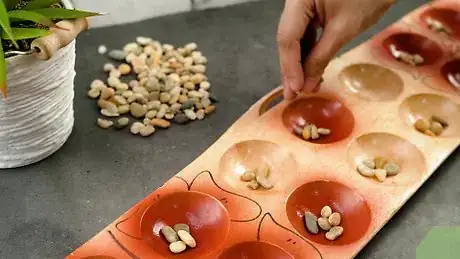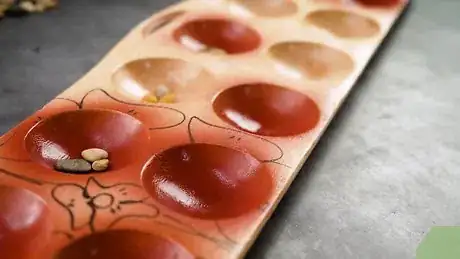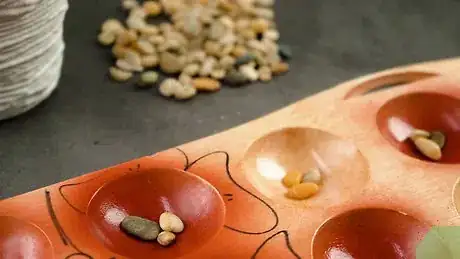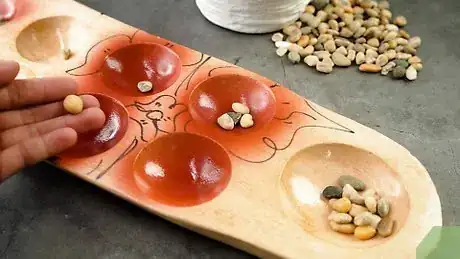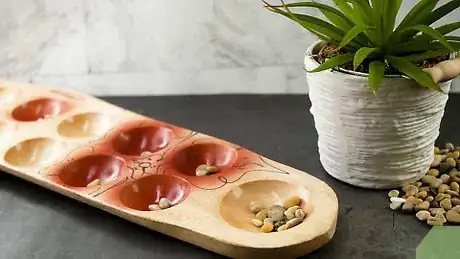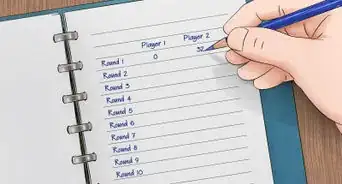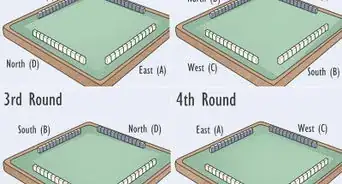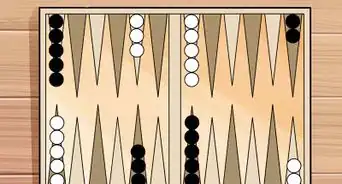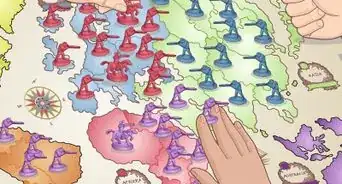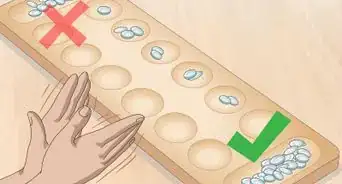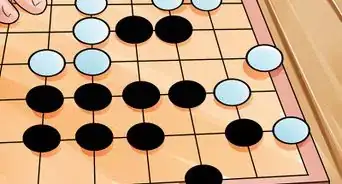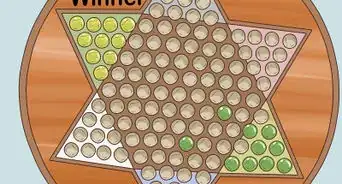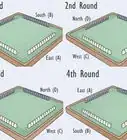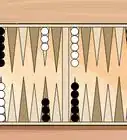This article was co-authored by wikiHow Staff. Our trained team of editors and researchers validate articles for accuracy and comprehensiveness. wikiHow's Content Management Team carefully monitors the work from our editorial staff to ensure that each article is backed by trusted research and meets our high quality standards.
The wikiHow Video Team also followed the article's instructions and verified that they work.
This article has been viewed 64,812 times.
Learn more...
People play the strategy game mancala using stones on a board with cups in it. The object of the game is to be the first player with the most stones in your mancala or home base. Capturing your opponent’s stones helps you to get to this goal faster! Learn the basics of the game, and then use capturing strategies to help you win faster. There are only a couple of ways to capture in mancala, so learning these winning strategies is easy.
Steps
Mastering the Basics of Mancala
-
1Place 4 stones into each of the 12 cups. Mancala sets come with a total of 48 stones or marbles. Divide these between you and your opponent so that each of you has 24 stones. Place 4 of your stones into each of the 6 cups on your side of the board and have your opponent do the same. Don’t put stones into the mancalas (home cups) at the ends of the board.[1]
Tip: Some mancala boards don't have mancalas. If you have a board like this, collect the stones you capture in a small pile in front of you or in a bowl.[2]
-
2Pick up the stones from 1 of your cups on your turn. To start the game, choose someone to go first. You can do this by tossing a coin or let the youngest player go first. On your turn, pick up the stones in 1 of the cups on your side of the board.[3]
- Never pick up stones from your opponent’s side of the board to start your turn. You must start your turn by emptying one of your cups.
Advertisement -
3Place 1 stone into each of the cups to the right of that cup. Redistribute the stones into the cups to the right. Move counter-clockwise around the board to redistribute any remaining stones. Only put 1 stone into each cup. When you reach the end of your row, place 1 stone into your mancala, but don’t put a stone into your opponent’s mancala if you pass it.[4]
-
4Take turns to continue playing the game. After you finish placing all of your stones into cups, your turn is over. Allow your opponent to do the same on their turn. Alternate turns with your opponent until someone wins the game.
-
5End the game when all the cups on 1 side of the board are empty. It does not matter if you or your opponent is the first player with empty cups on their side. When 1 of you has no stones in any of the 6 cups on your side, the game is over. Stop taking turns at this point.[5]
- For example, if you empty the last of your cups on your turn, then the game would end right after your turn. Play would not pass to your opponent.
-
6Count your stones to see who has the most. The player with the most stones is the winner, so count your stones and have your opponent do the same. If you have the most stones, then you win. If your opponent has the most stones, they win. It does not matter how many more stones you have than your opponent or vice versa.[6]
- For example, if you have 26 stones and your opponent only has 18 stones, then you win the game. But if your opponent has 21 stones and you have 20, then your opponent is the winner.
-
7Note that there will still be stones on the board when the game is over. Only 1 side of the board needs to be empty to end the game. Any stones that remain on the board will not count towards either player’s points. For example, say your opponent ends the game by clearing the stones from their side, but you still have stones on your side. These stones do not count towards either of your points. The person with the most stones in their mancala is the winner.[7]
- For example, if you have 21 stones in your mancala and your opponent has 20 stones, then the other 7 stones still on the board are neutral. You would be the winner because you have the most stones.
Capturing Stones from Your Opponent’s Side
-
1Identify a move that would end on an empty cup on your side. You have to have enough stones in the cup to go all the way around the board and back to your own side. By placing your last stone into an empty cup on your side, you can capture your opponent’s stones in the opposite cup. Look for a cup that would allow you to do this. Then, find a cup with the right amount of stones in it and collect them.[8]
- For example, if you see an empty cup on your side and spot a cup 2 spaces away with 2 stones in it, then pick up these stones to make the move.
Tip: This move works best after you and your opponent have taken several turns. You won't have any empty stones at the beginning of the game.
-
2Place 1 stone into each space going counter-clockwise. After you pick up your stones, drop only 1 into each cup ahead of that cup. Move counter-clockwise around the board.[9]
- Keep dropping 1 stone at a time until you reach the last space, then drop that stone as well.
-
3Collect the stones in your opponent’s cup across from your cup. As long as the last cup you dropped a stone into was on your side and empty, you may capture the stones in your opponent’s cup. You also get the stone you placed into your cup.[10]
- For example, if there are 4 stones in your opponent’s cup, then capture those 4 plus your 1 stone for a total of 5 stones.
- Remember, it does not matter how many stones are in your opponent’s cup. Whether there is 1, 2, 3 or more stones in a cup, you get to capture them all using this strategy!
-
4Place your opponent’s stones and your stone into your mancala. Once you have gathered up your stones and your opponent’s stones, place them into your mancala. These stones are now yours.[11]
- If your board does not have mancalas, then place the stones you capture into a dish or pile in front of you.
- Note that after you capture, your turn is over and it is your opponent’s turn.
Using the Wari Variation to Capture
-
1Determine if you will be playing by Wari rules before you start. In this variation, you can capture stones the normal way, or depending on the number of stones in your opponent’s cups. If the last cup you place stones in on your turn is an opponent’s cup with 2 or 3 stones in it, capture the stones in that cup. You can also take the stones in any other preceding cups with 2 or 3 stones in them.[12]
- For example, if you place 1 stone into 4 of your opponent’s cups and they each have 2 or 3 stones in them after you do this, then you can capture the stones in all 4 cups.
- However, if only the first and last cup out of 4 have 2 or 3 stones in them, then you can only capture the stones in these cups.
-
2Look for cups that have 1 or 2 stones and target those cups. You need to have enough stones in your cup to go around your side to the opponent's side of the board. Before you start your turn, look to see if your opponent has any cups with 1 or 2 stones in them. If they do, then you can capture these stones by placing stones into them for a total of 2 to 3 stones per cup. Gather up stones from 1 of the cups on your side of the board. Choose a cup that will allow you to put stones in cups on your opponent’s side.[13]
Tip: You can also try to prevent your opponent from using this strategy on your cups. Place stones into cups on your side that only have 2 stones in them. This will ensure that each cup has 3 stones at the end of your turn, and your opponent would be adding a 4th stone to the cups. That will prevent your opponent from collecting these stones.
-
3
-
4Gather the stones in previous cups if they also have 2 to 3. Make sure to check the previous cups that you dropped stones into as well. If any cup before the last one has 2 to 3 stones in it, then you may also collect these stones.[16]
- After you finish your capture move, let your opponent take their turn.
References
- ↑ https://www.fgbradleys.com/rules/Mancala.pdf
- ↑ https://www.youtube.com/watch?v=iSJk6CYsf6c&feature=youtu.be&t=130
- ↑ https://www.fgbradleys.com/rules/Mancala.pdf
- ↑ https://www.fgbradleys.com/rules/Mancala.pdf
- ↑ https://www.fgbradleys.com/rules/Mancala.pdf
- ↑ https://www.fgbradleys.com/rules/Mancala.pdf
- ↑ https://www.fgbradleys.com/rules/Mancala.pdf
- ↑ https://www.fgbradleys.com/rules/Mancala.pdf
- ↑ https://www.fgbradleys.com/rules/Mancala.pdf
- ↑ https://www.fgbradleys.com/rules/Mancala.pdf
- ↑ https://www.youtube.com/watch?v=iSJk6CYsf6c&feature=youtu.be&t=130
- ↑ https://www2.palomar.edu/users/warmstrong/wari.htm
- ↑ https://www2.palomar.edu/users/warmstrong/wari.htm
- ↑ https://www2.palomar.edu/users/warmstrong/wari.htm
- ↑ https://www.youtube.com/watch?v=v9LNUvHqXeQ&feature=youtu.be&t=360
- ↑ https://www2.palomar.edu/users/warmstrong/wari.htm
About This Article
One simple way to capture your opponent’s stones is to use an empty cup on your side. As you redistribute your stones around the board, look out for empty spaces. Try to play a move that will end with you putting a stone in one of those empty cups on your side. When you do that, you can capture your opponent’s stones from the opposite cup, as well as the stone you just placed in your own cup. If you’re playing the Wari variant, you can also capture stones if you end your turn on your opponent’s side. However, you can only do this if you land in a cup that has 2 or 3 stones in it. You can also capture the stones in any other cups from that turn that contain 2 to 3 stones. To learn the basic rules of mancala, scroll down!

